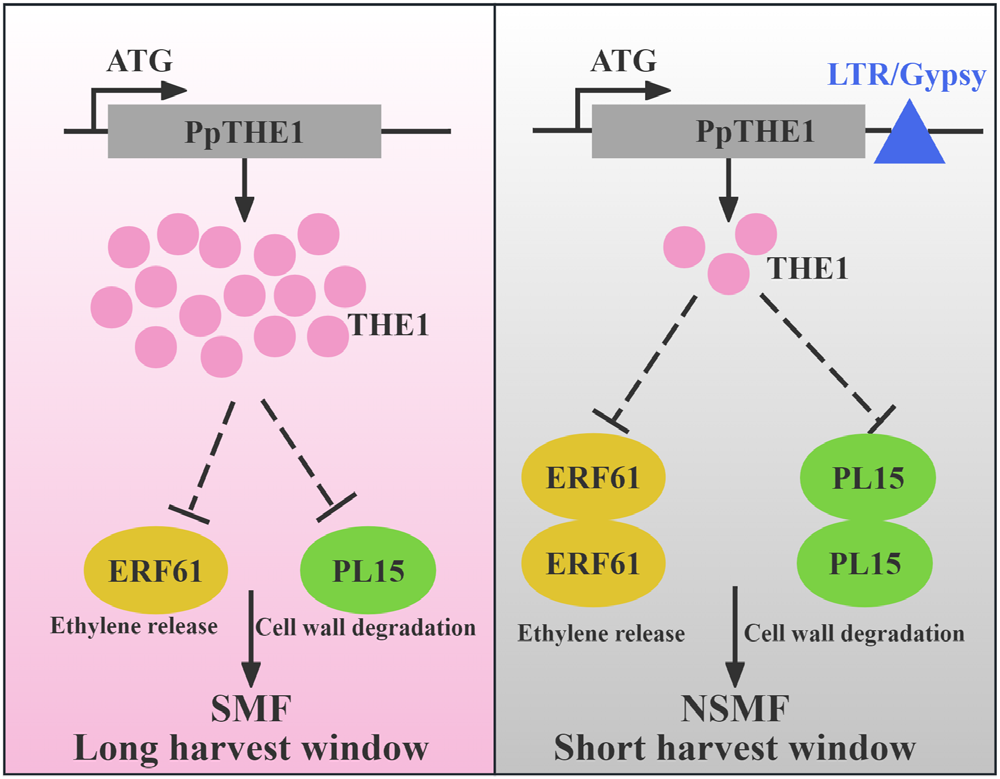Recently, the Peach Breeding Team from the Zhengzhou Fruit Research Institute of the Chinese Academy of Agricultural Sciences (CAAS) published a research paper titled “Identification of PpTHE1, a cell wall integrity sensor regulating the increased duration of harvest window in slow-melting flesh peach, through the assembly of a chromosome-level reference genome of Prunus persica” in Plant Biotechnology Journal. This study first identified the mechanism by which the receptor-like protein kinase PpTHE1 regulates the formation of the slow-melting flesh trait in peach fruit.
Fruit texture is crucial for storage and transport. Currently, peaches are primarily classified as melting-flesh (with soften rapidly and shorter shelf life. NMF peaches are suitable for canning with MF), non-melting flesh (NMF), and stony hard (SH). MF peaches are ideal for consumed fresh firm yet pliable flesh. SH peaches possess excellent storage and transport properties but lack aroma. Recently, slow-melting flesh (SMF) peaches have been emerging for their unique texture. These fruits exhibit an extended harvest window, normal softening, preserved flavor and quality, and reduced losses from untimely harvesting. Therefore, identifying the genes and regulatory network controlling SMF is vital for breeding peaches with superior storage, transport tolerance, and genetic improvement.
The team constructed a high-quality, chromosome-level genome of SMF peach 'Chun Rui'. Using an F1 segregating population, they mapped the SMF trait to a 1.39 Mb interval on chromosome 4 and identified the candidate gene PpTHE1 with a significantly high expression in SMF fruit. Moreover, they discoved a Gypsy-LTR retrotransposon downstream of PpTHE1 that inhibits its expression. Functional validation through tomato transgenic and peach transient transformation assays confirmed that PpTHE1 negatively regulates the softening of fruit. Subsequently, investigations revealed that the peach fruit softening regulator PpERF61 and the pectate lyase PpPL15 could interact with PpTHE1. PpTHE1 not only suppresses the expression of PpERF61 and PpPL15, but also attenuates the transcriptional activation of downstream target genes by PpERF61. This study provides important genetic resources for improving peach fruit texture.

Proposed model for regulation of the slow-melting flesh trait
Ph.D. Meng Junren is the first author of the paper. Professor Zeng Wenfang from the Zhengzhou Fruit Research Institute, CAAS, and Professor Xu Juan from Huazhong Agricultural University are the corresponding authors. This study was supported by the National Natural Science Foundation of China (grant No. 32472699), Collaborative Research Project of the Shennong Laboratory (SN02-2024-01), the Agricultural Science and Technology Innovation Program (ASTIP) (CAAS-ASTIP-2024-ZFRI), and the China Agriculture Research System (CARS-30-2-01).
Article link:
https://onlinelibrary.wiley.com/doi/10.1111/pbi.70222
By Sun Shihang
sunshihong@caas.cn
